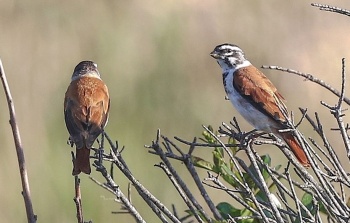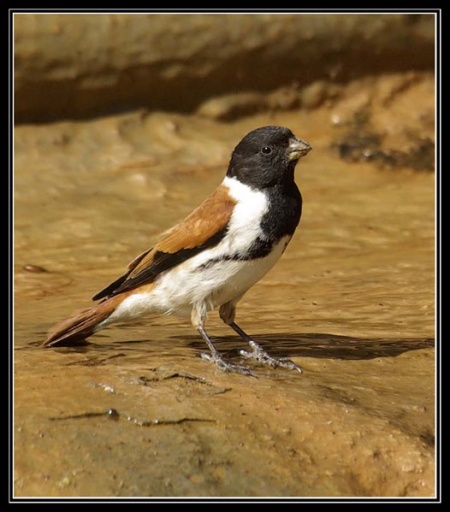JohnN-1520 (talk | contribs) |
(Picture of subspecies. Imp sizes. References updated) |
||
| (11 intermediate revisions by 4 users not shown) | |||
| Line 1: | Line 1: | ||
| − | {{ | + | [[Image:Swartkopkanarie.jpg|thumb|450px|right|Photo by {{user|Twinspot|Twinspot}} <br />[[Tankwa Karoo National Park]], Northern Cape Province, [[South Africa]]]] |
| − | ;Serinus alario | + | ;[[:Category:Serinus|Serinus]] alario |
| + | ''Alario alario'', ''Crithagra alario''<br /> | ||
| + | '''Includes Damara Canary''' | ||
| + | ==Identification== | ||
| + | [[Image:S64A6176-2.jpg|thumb|350px|right|Damara Canary, subspecies ''leucolaemus''<br />Photo by {{user|max1|max1}}<br />West Coast Nat Park, Cape, [[South Africa]], October 2017]] | ||
| + | Length 12–13 cm (4¾-5 in), mass 11-13 g. A striking canary with bold colouration.<br /> | ||
| + | '''Adult male''' (''S. a. alario''): Head, neck, chin, throat and centre of upper breast black, extending in an inverted 'V' to the lower breast; belly, centre of lower breast, flanks, and sides of the upperbreast white; back, rump, tail and wing coverts chestnut.<br /> | ||
| + | '''Adult female''': Grey head, throat and breast, and white belly; chestnut back, tail and wing coverts. | ||
| + | ==Distribution== | ||
| + | [[South Africa]], [[Namibia]] and [[Lesotho]]. | ||
| + | ==Taxonomy== | ||
| + | This species has two subspecies:<sup>[[#References|1]]</sup> | ||
| + | *''S. a. alario'' | ||
| + | :*Southern [[Namibia]], [[South Africa]] from the west coast to [[Lesotho]], and [[Lesotho]]. | ||
| + | *''S. a. leucolaemus'' | ||
| + | :*Range overlaps with ''S. a. alario'', but extends further north in [[Namibia]], and not as far south or west in [[South Africa]]. | ||
| + | :*Male has a pied (rather than black) head, with a white eyebrow, cheeks, chin and throat; female has a faint whitish head pattern similar to that of the male. | ||
| + | Some authorities<sup>[[#References|2]],[[#References|3]]</sup> consider ''S. a. leucoleamus'' a separate species, the '''Damara Canary''', ''Serinus leucolaemus''.<br /> | ||
| + | This species was formerly placed in genus [[:Category:Alario|Alario]] by Clements. | ||
| + | ==Habitat== | ||
| + | Arid to semi-arid shrublands and grasslands; also weedy road verges, croplands and gardens. | ||
| + | ==Behaviour== | ||
| + | Found in pairs or family groups when breeding; when not breeding, forms flocks of up to several hundered birds. | ||
| + | ====Diet==== | ||
| + | Forages on the ground and in shrubs, trees and grasses for seeds; also eats buds, petals, fruit and termites. | ||
| + | ====Breeding==== | ||
| + | Probably monogamous and territorial. The nest is a cup built by the female using dry grass, twigs and bark and lined with plant down; placed within a metre of the ground in a shrub or small tree. Two to five eggs are laid; incubated for 13-14 days by the female. | ||
| + | ==References== | ||
| + | #{{Ref-Hockeyetal05}}#{{Ref-SinclairRyan03}}#{{Ref-Clements6thAug17}} | ||
| + | {{ref}} | ||
==External Links== | ==External Links== | ||
{{GSearch|Serinus+alario}} | {{GSearch|Serinus+alario}} | ||
| − | [[Category:Birds]] [[Category: | + | [[Category:Birds]] [[Category:Serinus]] |
Revision as of 23:35, 1 November 2017
- Serinus alario
Alario alario, Crithagra alario
Includes Damara Canary
Identification

Photo by max1
West Coast Nat Park, Cape, South Africa, October 2017
Length 12–13 cm (4¾-5 in), mass 11-13 g. A striking canary with bold colouration.
Adult male (S. a. alario): Head, neck, chin, throat and centre of upper breast black, extending in an inverted 'V' to the lower breast; belly, centre of lower breast, flanks, and sides of the upperbreast white; back, rump, tail and wing coverts chestnut.
Adult female: Grey head, throat and breast, and white belly; chestnut back, tail and wing coverts.
Distribution
South Africa, Namibia and Lesotho.
Taxonomy
This species has two subspecies:1
- S. a. alario
- Southern Namibia, South Africa from the west coast to Lesotho, and Lesotho.
- S. a. leucolaemus
- Range overlaps with S. a. alario, but extends further north in Namibia, and not as far south or west in South Africa.
- Male has a pied (rather than black) head, with a white eyebrow, cheeks, chin and throat; female has a faint whitish head pattern similar to that of the male.
Some authorities2,3 consider S. a. leucoleamus a separate species, the Damara Canary, Serinus leucolaemus.
This species was formerly placed in genus Alario by Clements.
Habitat
Arid to semi-arid shrublands and grasslands; also weedy road verges, croplands and gardens.
Behaviour
Found in pairs or family groups when breeding; when not breeding, forms flocks of up to several hundered birds.
Diet
Forages on the ground and in shrubs, trees and grasses for seeds; also eats buds, petals, fruit and termites.
Breeding
Probably monogamous and territorial. The nest is a cup built by the female using dry grass, twigs and bark and lined with plant down; placed within a metre of the ground in a shrub or small tree. Two to five eggs are laid; incubated for 13-14 days by the female.
References
- Hockey, PAR, WRJ Dean, and PG Ryan, eds. 2005. Roberts' Birds of Southern Africa. 7th ed. Cape Town: John Voelcker Bird Book Fund. ISBN 978-0620340533
- Sinclair, I and P Ryan. 2003. Birds of Africa South of the Sahara. Princeton: Princeton Univ. Press. ISBN 978-0691118154
- Clements, J. F., T. S. Schulenberg, M. J. Iliff, D. Roberson, T. A. Fredericks, B. L. Sullivan, and C. L. Wood. 2017. The eBird/Clements checklist of birds of the world: v2017, with updates to August 2017. Downloaded from http://www.birds.cornell.edu/clementschecklist/download/
Recommended Citation
- BirdForum Opus contributors. (2024) Black-headed Canary. In: BirdForum, the forum for wild birds and birding. Retrieved 26 April 2024 from https://www.birdforum.net/opus/Black-headed_Canary




